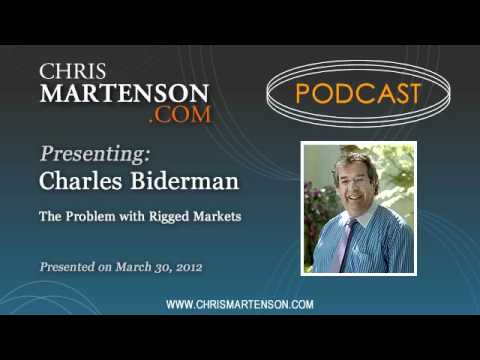 "Even Wile E. Coyote had to come back down to earth sooner or later", says Charles Biderman, founder of TrimTabs Investment Research. In his opinion, the prices of stocks and bonds - enabled by excessive financialization of our economy and central bank money printing - have been defying gravity for a dangerously long time.
"Even Wile E. Coyote had to come back down to earth sooner or later", says Charles Biderman, founder of TrimTabs Investment Research. In his opinion, the prices of stocks and bonds - enabled by excessive financialization of our economy and central bank money printing - have been defying gravity for a dangerously long time.
If we continue to do all we can to preserve the status quo -- to maintain "phony" asset price levels as Charles calls them -- at best we will restrict overall growth and handicap the economy.
The problem isn't so much the unfairness and malinvestment evident in a rigged market. As Charles shrewdly asks: what happens when the market becomes un-rigged?
We've never experienced the unwinding of an entirely manipulated financial system, so we can't predict for sure. But at this point, a painful collapse of our markets and loss of the US dollar as the world's reserve currency seem entirely plausible.
On Market Manipulation
The market is rigged. In January of ’10, I went on CNBC and on Bloomberg and said that there is no money coming into stocks, and yet the stock market keeps going up. The law of supply and demand still exists and for stock prices to go up, there has to be more money buying those shares. There is no other way in aggregate that that could happen.
So I said it has to be coming from the government. And everybody thought I was a lunatic, conspiracy theorist, whatever. And then lo and behold, on October of 2011, Mr. Bernanke then says officially, that the purpose of QE1 and QE2 is to raise asset prices. And if I remember correctly, equities are an asset, and bonds are an asset.
So asset prices have gone up as the Fed has been manipulating the market. At the same time as the economy is not growing (or not growing very fast).
On the Future of the Dollar
At some point, the world is going to recognize the Emperor is naked. The only question is when.
Will it be this year? I do not think it will be before the election, I think there is too much vested interest in keeping things rosy and positive. And I just do not see it happening soon.
However at some point, hard money wins out over phoney money. And of the investor class or those with capital, which right now seems to be the emerging markets, they are buying gold and bullion and they are not buying dollars. Or China appears to have slowed their buying of dollars, even though China might be having their own growth problems, or their own bad debt problems. But Singapore and all those other countries with huge cash flows, the emerging world, I would not be surprised -- maybe by 2013 of 2014 -- seeing a non-US dollar alternative currency by those countries.
On the Challenge Facing Investors
We are in strange, uncharted territory.
I think is very important for people to realize, in 1981, before the market crossed 1,000, the Dow crossed 1,000 in early ’82, and stayed above that, the value of all U.S. Stocks was about $800 billion. And in October of ’07, it peaked at $22 point something trillion. And it is back up to $19.4 trillion.
So in 1981, there was maybe 100 hedge funds or less, I am sure less. And maybe 100 or so equity mutual funds. And 3,000 stocks, you know, institutional size and sorts back then. Now there is still 3,000 stocks, but there is 4,500 equity mutual funds, 10,000 hedge funds. The real wealth created in the last 30 years has been in the equity market, not in earnings. I mean earnings are up several times, four or five times take home pay is up -- but the market is up 19-20 times.
Over that time, we have the boomers entering their peak earning years, as well as technical advances like the Internet. You know, more people in the last 30 years have gone from calorie insufficiency to calorie sufficiency as a percentage of the population than going back to the first time we industrialized in the 19th century. So it is like this huge increase in wealth and calories and our goal across the globe, and a lot of that money went into the real estate markets and went into the equity markets -- and boosted home prices, and stock prices dramatically, and now it is unwinding.
All booms create excesses and excesses are painful as the excesses from the boom are worked off and worked out. And that is the process we are in, and in the past it has taken 13 to 17 years to work off those excesses. And we are still not even through year five.
Click the play button below to listen to Chris' interview with Charles Biderman (runtime 36m:10s).
iTunes: Play/Download/Subscribe to the Podcast
Download/Play the Podcast
Report a Problem Playing the Podcast
Or click here to read the full transcript.
Charles Biderman is the Founder and Chief Executive Officer of TrimTabs Investment Research and Portfolio Manager of the TrimTabs Float Shrink ETF (TTFS). After earning his MBA from Harvard Business School, he began his career as Alan Abelson’s assistant at Barron’s from 1971 to 1973. There he predicted the collapse of real estate investment trusts (REITs). After Barron’s, he worked in the Wall Street short selling community and recommended shorting REITs on their way to perdition. In 1990, Mr. Biderman founded Market TrimTabs in Santa Rosa, California.
Our series of podcast interviews with notable minds includes:
- Gretchen Morgenson
- Chris Martenson (answers your questions - part 2)
- Marc Faber
- Robert Mish
- Erik Townsend
- Ben Davies
- Jim Rickards
- Chris Martenson (answers your questions)
- Charles Eisenstein
- James Dines
- John Mauldin
- Jack Keller
- Rick Rule
- Robert Rapier
- Gordon Chang
- Turd Ferguson
- Eric Janszen
- Paul Brodsky
- Carolyn Baker
- David Stockman
- Rob Hopkins
- Joel Salatin
- Charles Hugh Smith
- Frank Barbera
- Nate Hagens
- David Morgan
- James Turk
- Eric Sprott
- John Rubino
- Addison Wiggin
- Simon Black
- Axel Merk
- Paul Tustain
- Francis Koster
- Dogs_In_A_Pile
- Bud Conrad
- John Williams
- Robert McFarlane
- David Collum
- Joe Saluzzi
- Jim Rogers
- Bill Fleckenstein
- Marc Faber
- Willet Kempton
- Dan Ariely
- Ted Butler
This is a companion discussion topic for the original entry at https://peakprosperity.com/charles-biderman-the-problem-with-rigged-markets-2/
